|
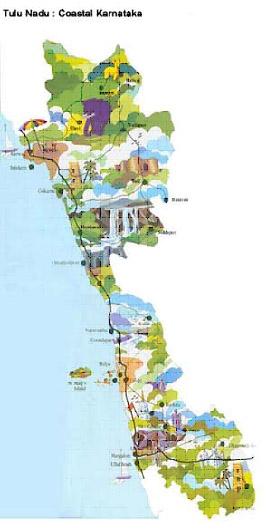
Karnataka is not a homogeneous state as evidenced by its diversity. Kannada spoken in different regions of the state has been “colloquialized “, to such an extent that in many instances it is incomprehensible to one well versed in classical Kannada. Even more surprising is the presence of two districts in Karnataka that speak entirely different languages, which makes one wonder how they were classified under the linguistic state of Karnataka. These two regions are Tulu Nadu and Kodagu. Though Kannada is the official language, the spoken languages here differ a great deal from it. When the history of Tulu Nadu is studied, the reasons for it to be included in Karnataka become apparent.
The areas currently known as Dakshina Kannada and the coastal part of the adjacent district Uttara Kannada up to Gokarna are the historical Tulu Nadu. Many centuries ago the center of Tulu culture was probably in the Uttara Kannada (Honnavara), and Udupi as well as Mangalore were at the periphery. Today, however, Tulu is spoken only in the region below River Kalyanpur. The people living north of the river now speak Kannada. The reason for this is not clear in history. The region, although it maintained some form of independence, was always under the suzerainty of various rulers and dynasties that controlled Karnataka. Tulu Nadu was originally called Alvakheda (a second century C.E. reference from Greece calls it Olokhoira). Many historians agree that this is the region Emperor Ashoka referred to in his edicts as Satiyaputra, one of the four regions outside of his empire (the other three being Chola, Chera and Pandya kingdoms).
The political history of Tulu Nadu can be classified as follows:
1. The Alupa (Aluva) period
2. The Rayas of Vijayanagara period
3. The Nayaks of Keladi period
4. The Sultans of Mysore period
5. The British period.
6. Post Independence period.
The longest reigning dynasty of Tulu Nadu was the Alupas (Aluvas). Switching between Mangaluru and Udyavar, Barakuru and back to Mangaluru as their political centers, Alupas have the distinction of a continuous dynasty for more than one thousand years. They were the feudatories of the prominent dynasties of Karnataka. Kadamba dynasty of Banavasi was the earliest, under which the Alupas flourished. Later the Rashtrakutas of Manyakheta, Chalukyas of Badami, Chalukyas of Kalyani, Hoysalas of Durasamudra and Rayas of Vijayanagara were the overlords. Alupas, however, were independent and their subordination was nominal at best. They ruled until the Vijayanagara kings totally dominated the Tulu Nadu from 14th to the 17th centuries. The region became extremely prosperous during Vijayanagara period with Barakuru and Mangaluru gaining importance. After the decline of Vijayanagara Empire, the Nayaks of Keladi (Ikkeri), who controlled much of Tulu Nadu, let it decline and internal skirmishes eventually led to it being controlled, at the end of 18th century, by the Sultans of Mysore, namely Haider Ali and Tippu Sultan. Mangalore played a prominent role in Tippu’s battles with the British. Tippu’s French alliance also led to some French presence in Mangalore. The British gained full control in 1801, after the defeat of Tippu in 1799. The British ruled the region with Madras as its headquarters. When the Indian independence was achieved in 1947, Tulu Nadu became part of Madras state. When the states were divided into linguistic states in the 1950’s, Tulu Nadu became part of Karnataka.
Much of the land known as Tulu Nadu was under sea eons ago. There is fossil evidence to support this. This might even have led to the legend of coastal Karnataka as a creation of Parashurama. Lord Parashurama was said to have had a dispute with the lord of the seas, Varuna. In a rage he threw his axe and claimed the coastal region from the sea, part of which is Tulu Nadu. Hence the region is referred to as “Parashurama Srishti.” Visits to seven well-known temples of Parashurama kshetra (Tulu Nadu) will bring countless blessings to the devotees. The seven temples all nestled in the coastal Karnataka are in Udupi, Kolluru, Subramanya, Gokarna, Kumbasi, Koteshvara and Shankaranarayana. They are collectively called mukti sthalas.
Proof of earliest human habitation is from about 10,000 years ago. Before the Kadambas of Banavasi invited Brahmins in the 5th century to settle in the region, the people were mainly spirit-worshippers (bhuta-aradhana). Brahmins brought Vedic culture to Tulu Nadu. In the 8th century Shankaracharya had a profound effect on the theology and philosophy of the educated class. He had visited Subramanya and Kolluru, where he won over many theologians in discursive debates. Advaita philosophy of Shankaracharya became popular.
Over the following many centuries, more ethnic groups migrated to the area. Konkanas from Maharashtra and many of their sub-sects moved to Tulu Nadu, mainly seeking business opportunities. Konkanas and Gouda Sarasvats were said to have come by sea, as Mangalore was a major port that was serving not only the Portuguese but also the Arabs for maritime trades. Jains were already a prominent group and even today are uniquely preserved in Tulu Nadu. Their prominence declined not only after the Hoysala king, Vishnuvardhana converted to Hinduism – with the influence of Ramanujacharya in Melukote – but also because of targeted decimation of their population by the Muslim rulers in the North. The strong influence Madhvacharya had in the region also played an important role in decline of other religions. However, Jain community thrived in smaller numbers, in the relative safety of Tulu Nadu. The ancient Jains have left behind indelible reminders of their glory with temples-bastis- (Mudabidri) and monolithic statues of Bahubali, the gomateshwara in Karkala, Venoor and now in Dharmasthala.

The Alupas (or Aluvas-hence the term Alvakheda) who were ruling Tulu Nadu continuously for more than one thousand years have left few reminders of their existence except for some forts, which are in ruins. Their descendents are now in the Jain as well as non-Brahmin communities. Madhvacharya in the 13th century built the eight monasteries (Matths) in Ududpi, which became the nucleus of Hindu theosophy. In the 16th century there was a large influx of Catholics to Tulu Nadu. They arrived from Goa, mainly as farmers and had a close association with the Portuguese. They quickly became successful landowners but suffered a setback under Haider Ali and Tippu Sultan in late 18th century. About 60,000 of them along with Portuguese Christians were interned in Srirangapatnam, when their loyalty was questioned and they were accused of colluding with the British. Only after Tippu’s death in 1799 did the survivors return to Tulu Nadu, once again to become a prosperous community. A glorious church, inspired by the Sistine chapel of the Vatican, built in Mangalore (at St. Aloysius College campus) is a monument to the Catholic architecture. They also excelled at building educational institutes. The Muslim community of Tulu Nadu is also prominent. They have had close ties to the Muslims of Kerala and even speak a language that is a combination of Malayalam and Tulu. Their population increased during the rules of Bijapur sultans and the sultans of Mysore. They, along with the Konkanas have carved a niche in the business society of Tulu Nadu.
All these communities live in harmony in Tulu Nadu today. This has given it a diverse culture and society. The Brahmins, Konkanas, non-Brahmin Hindus, Jains, Catholics and the Muslims play a pivotal role in the local economy. Having vastly different landscapes, from seashores to mountainous Western Ghats, with their rain forests, give the region a unique advantage. Farmers, landowners, businesspeople and professionals are to be found in all the communities. The once prevalent separation according to castes is no longer seen in Tulu Nadu.
According to Professor P. Gururaja Bhatt, there are five distinct features of Tulu Nadu that separates it from the rest of Karnataka. These give an exclusive Tuluva flavor to the region:
1. Bhuta-nritya or spirit-dance: This practice can be still seen played in villages and many bhutas are still worshipped (see later).
2. Naga-mandala and Dakke-bali: An elaborate form of serpent worship, unique to Tulu Nadu. There is a distinct form of dance associated with it that is akin to yakshagana. It is performed only by a group of people who call themselves Vaidyas.
3. Aliya-santana: The practice of inheritance passing to the nephew (maternal), instead of one’s progeny. This along with 14 kattus and 16 kattales (laws governing the society), is seen in the non-Brahmin community. Similar to the gothras of Brahmin community, the ancestral lineage is traced through bali (Dravidian system).
4. Tulu language, spoken nowhere else, serves as a bond between the people of different communities, giving them a sense of separation from the rest of South India.
5. Tatva-vada of Sri Madhvacharya (birth place of Dvaita philosophy). If Christianity influenced Madhva philosophy, as proposed by some experts, the influence of Christianity in the region was long before the appearance of the Portuguese in the 16th century.
To this may be added the extraordinary dance ritual of yakshagana, which is practiced in the form of bayalata, in open-air theaters. It is the rendition of stories of the Hindu mythology and Puranas in the form of dance-drama. The most popular theme for bayalata is the story of Koti–Channaye, which has deep-rooted mythical significance in Tulu Nadu.
The origin of naga-mandala is still a mystery. It seems to be a remnant of some ancient tribal worship of the serpent god: naga. The naga-bandha is an art that is drawn at the time of the dance ritual. The dance is associated with the families of Vaidya and the origin of such families is also lost in obscurity. Naga-mandala ritual is practiced in only four districts in Dakshina Kannada, namely Udupi, Karkala, Puttur and Mangalore. One naga-patri (possessed one) and three or more Vaidyas dance around the naga-bandha for hours, to the music of drums (called dakke or damaruka) and cymbals, in a trance like manner. It is believed that the ritual will absolve the attendees of the curse of the serpent and protect them from leprosy. It also restores prosperity of progeny and begets children to barren couples.
Bhuta-aradhana in Tulu Nadu is similar to the rest of South India though the bhutas as well as
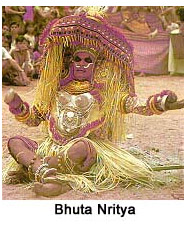
their worship differ. The kola or nema is the yearly ceremony celebrating the festival of bhutas. They have attained a godly status among some worshippers, mainly non-Brahmins, and even have their own bhuta-sthanas (a place of abode similar to temples). Bhutas can be animistic as in Panjurli (pig) or Pili-bhuta (tiger). However, in many villages the Brahmins, who consider these spirits as their protectorates, conduct the yearly ceremonies. A second variety can be representatives of characters taken out of the Puranas like Berme (Brahma), Lekkesiri (Raktesvari, Kali) or Vishnumurti etc. A third category is deified human beings like Gulige, Annappe, and Koti-Chananye etc. The fourth kind is strictly local characters like Male-Chandi (from the male-Nadu), Ullaldi (from Ullal), and Malaraye (from the Ghats). Then there are devils which provide comical relief during nemas, namely Marlu-Jumadi (crazy Jumadi) or Potte (dumb/deaf devil). Newer bhutas also have been added like Posa-bhuta (new devil), Vokku-Ballala, and Muttappe etc.
The legend of aliya-santana (as against makkala-santana) is traced back to Bhutala-Pandya in year 77 C.E. Deva-Pandya launched his newly built fleet of ships into sea but ran afoul with the lord of demons, Kundodara. The demon asked the king to give him one of his sons as sacrifice, the king's wife refused. Satyavati, the king’s sister offered her son, Jaya-Pandya instead. The demonic Kundodara was pleased by this act, honored the child and restored to him his father’s kingdom of Jayantika. Later, the same drama was played out again and this time the king’s wife not only refused to part with one of her sons but also publicly renounced her position as queen and her son’s rights for any property. Kundodara then instructed Deva-Pandya to disinherit his children and make his sister’s son (nephew) his legal heir. Jaya-Pandya was given the name Bhutala-Pandya and was seated on the throne, from where he ruled for 75 years. Thus was born the aliya-santana, where the nephew became the legal heir to property. From whence the practice of aliya-santana is prevalent in the region is not clear.
The etymology of Tulu language is also not known as well the meaning of the term Tulu is a matter of conjecture. There are half a dozen variations of spoken Tulu. An original Tulu script was thought to have never existed but a script resembling Malayalam was used to write it. Brahmins seeking further knowledge in agama shastra went to Kerala and jotted down notes in a script that was thought to be heavily borrowed from Malayalam. This came to be known as Tulu script, which later became extinct due to disuse. However, the close resemblance to Malayalam may have created the impression that Tulu is not a legitimate language with its own script. More recent discovery of some Tulu literature (two poems and one prose) may yet prove that Tulu had its own script derived from Grantha script just like other Dravidian languages like Tamil and Malayalam. It is now strongly believed that the script of Malayalam (which evolved much later than Tulu) was derived from the original Tulu script and not the reverse. With their close association with Karnataka throughout its history, the Kannada language is the official language of governance and trade. More and more evidence has been gathered to suggest that Tulu is one of the oldest Dravidian languages (one of five) with its own script, and preceded many of the major languages of the South used today.
Madhvacharya’s tatva-vada or Vaishnava-siddhanta took shape in Udupi in the 13th century. Madhva was a child prodigy, who had mastered Sanskrit by age five and the Vedas by the age of ten. He lived for eighty years and said to have joined his guru, Badarayana in the Himalayas in the year 1317. He was a well-built personality, a tall and strong-limbed man, interested in varied subjects including music, sculpture, debating and weight lifting. He has written 40 books, mostly commentaries on Vedanta, and established a unique approach to Vedantic philosophy. He claimed to be the third incarnation of Vayu, the sublime angel of God. His tatva-vada is referred to as Dvaita philosophy (dual). He founded the Sri Krishna temple in Udupi and the eight monasteries for the ascetics around the temple. Udupi became the center of devotional Hinduism and even today is considered as the hub of Vaishnavism and Vedanta. Madhvacharya was undoubtedly the most famous and influential personality of Tulu Nadu.
Over its history, Tulu Nadu has been the melting pot for outsiders. The immigration continues even in the modern era. Many Northerners like Gujaratis and Sindhis have settled in Mangalore and become successful businessmen. It is the largesse of the heart of Tuluva people that does not discriminate between the people of any ethnicity, caste or creed. This quality is deeply rooted in their history
The Tulu Language:
Its Script and Dialects
Tulu language is one of the five Dravidian languages of South India (Pancha- Bhasha, others are Tamil, Telugu, Kannada and Malayalam). The four major languages spoken today are dominantly spoken in their respective states (Tamilnadu, Andhra Pradesh, Karnataka and Kerala), whereas Tulu is spoken in a small niche, mainly in coastal Karnataka and Northern Karala (Kasaragod district). About 2.5 million people speak Tulu and call it their mother tongue. Tulu nadu is a region where many languages are spoken. While Kannada is the official state language, different ethnic communities in Tulu Nadu speak different languages. Tulu, derived from proto-Dravidian is the predominant language spoken by Hindus of various castes and by the Jains of Tulu Nadu. Konkanasthas and Catholics speak two variants of Konkani. Muslims speak a language of their own that is derived from Tulu as well as Malayalam.
There are about 24 Dravidian languages recognized by linguists. Of these the five languages in the South developed into major languages. Tulu is the only developed language that has not received the recognition it is due. However, Tulu language with its near extinct script has been generating much enthusiasm amongst the linguists, as it is now believed to be one of the oldest Dravidian languages.
The Script
The Tulu language has lost its prominence as a major language. Lack of serious literature in Tulu language has also hampered its claim as a language to be taught in educational institutes. Though it is certain that most of the literature has been lost because of difficulties in preserving palm leaf scrolls, the earliest literature available is from the 15th century. This indeed is a much later work than the language itself, which is thousands of years old. There was also some confusion regarding the script of Tulu language, which closely resembles Malayalam. It was thought that priests from Tulu Nadu went south to Kerala to perform and learn Agama Sastra rituals, where they jotted notes borrowing the Malayalam alphabets. This was the prevailing thought of many researches although now there is a consensus that Tulu language possessed its own script before Malayalam script existed. Perhaps the reciprocal is true that the Malayalam script developed from Tulu script as the language predates Malayalam by more than a thousand years. The priests who went south are now credited with carrying mantras written in Tulu script to Kerala. Like Tamil and Malayalam, Tulu script is derived from the Grantha* script.
| Sample of the basic Grantha Script |
Tulu Alphabets |
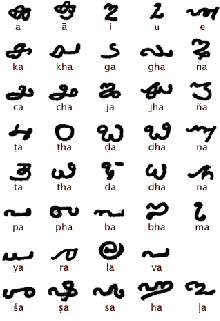 |
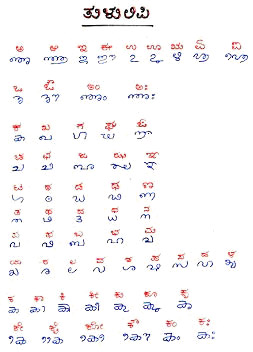 |
The earliest piece of literature, Tulu Mahabharata is from the 15th century written in Tulu script. Another manuscript that was discovered Tulu Devimahatme, a prose work like the Mahabharata, is also from the 15th century. Two epic poems written in 17th century namely Sri Bhagavata and Kaveri have also been found. Madhvacharya’s eight matts established in Udupi in the 13th century were centers of Tulu literature during his lifetime and thereafter. However, very little of this has survived. So it is not inconceivable (as it is claimed) that Madhvacharya himself did all his writings in the Tulu script. Other inscriptions discovered are Sanskrit mantras transliterated in Tulu script. It appears as though the Brahmins used the script mainly for this purpose.
In the first half of 19th century the German missionaries undertook a renaissance of the language. Unfortunately, they published Tulu literature and materials related to Christianity in the Kannada script as they had established printing presses in that language in Mangalore. In addition the German missionaries also produced Tulu lexicon and Tulu-English dictionary. They are also credited with transcription of Tulu folklore, Tulu proverbs and works on spirit worship in Tulu Nadu. Printing material in the Kannada script led to further disuse of the original Tulu script. By late 19th century Tulu script became remote and was endangered. Today there are no books or literature in the Tulu script and there are only a handful of Tuluvas who can read the script.
All the classic literatures discovered thus far are written only in one of the four dialects of the language, namely the Brahmin dialect. The dialect spoken by Brahmins in the southern part of Tulu Nadu is used in these manuscripts. The priests belonged to a sect of Tuluva Brahmins called the Shivalli Brahmins. (Only the Shivalli and the Sthanika sects in Tulu Nadu spoke the Brahmin dialect.) Tulu script was used by these Brahmins
to write mantras. The Brahmin dialect also has imported many Sanskrit words into its dialect and lexicon. The Common dialect, which is spoken by the non-Brahmin class, was not used in writings of Tulu. However, the Common dialect is used in many of the folk songs, proverbs and riddles. The folk songs called the Paaddanas are treasures reflective of the rich culture of Tulu Nadu. They also allow a glimpse into the society of Tuluva people. These were never written down and have been passed on through generations as oral traditional songs.
The Language and its Dialects
Research in Tulu language and script has been sorely lacking. In 1856 Robert Caldwell undertook a systematic study of the Tulu language with his monumental work, “A Comparative Grammar of Dravidian or South Indian Family of Languages.” Caldwell called Tulu one of the most developed Dravidian languages. In 1872 J. Bigel wrote, “Grammar of The Tulu Language.” Then in the 20th century S. U. Panniyadi and L.V. Ramaswamy Iyer published more books about its grammar. These authors contended that the language was well developed, and was one of the earliest off-shoots of proto-South Dravidian language, with many dialectal variations. (Tamil, Malayalam and Kannada also were derived from it, whereas Telugu was derived from proto-Central Dravidian). There is renewed interest in the language as evidenced by the fact that many universities both in India and abroad are promoting more research of Tulu language. Rashtrakavi Govinda Pai Research Center in Udupi has encouraged such research. Dr. D.N. Shankar Bhat and Dr. Padmanabha Kekunnaya have been doing commendable, ongoing research in the field.
From Encyclopedia Britannica
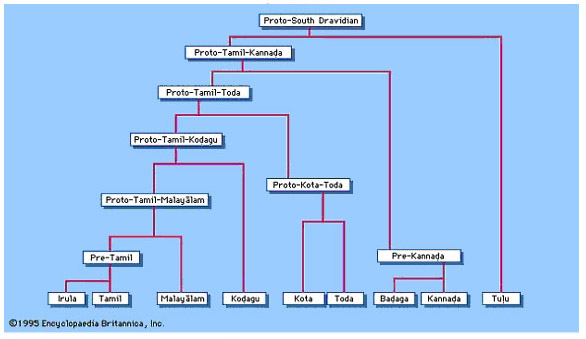
Different regions within Tulu Nadu developed its own dialect of the language. The language developed with various dialects and peculiarities, unimpeded by the proximity of the regions. Five main such geographical divisions with dialectal variations can be seen.
1. Southwest: comprising of Kasargod District of Kerala
2. Southeast: Includes Sullia and Kodagu
3. South Central: comprising of Puttur, Belthangady and Bantwal
4. Northwest: area including Mangalore and Udupi
5. Northeast: includes Karkala.
Other languages have influenced some of the dialects in these regions. Thus Malayalam may have influenced Tulu in the Southwest (Kasargod), whereas in other areas Kannada has influenced it. The differences in the society also influenced the dialects. Brahmins developed their own dialect influenced by Sanskrit that they were proficient in. Four main social dialects have developed.
1. Brahmin Dialect
2. Jain Dialect
3. Common Dialect and
4. Harijan/Tribal Dialect
Brahmin Dialect - spoken by Shivalli and Sthanika Brahmins - is the language used in writing the few classical literature discovered thus far. They also borrowed Sanskrit words and pronunciation of words. Even the local Dravidian words were enunciated with retroflex words (unusual in Dravidian languages, where non-retroflex sounds are used).
Jain Dialect spoken by the Jains in the northern part of Tulu nadu. They have a distinct dialect where the initial t and s have been replaced by letter h. As an example the word tare (head) is pronounced as hare. Saadi (path) is haadi.
Common Dialect is spoken by the majority of people (non-Brahmins) of Tulu Nadu, and is the dialect of commerce, entertainment and art. It is the language of the Paaddana. It is subdivided into more than five groups as spoken by Bunts, Billavas, Mogaveeras, Gowdas and Kumabaras etc. Due to the similarity in these dialects, they are grouped under the common heading of Common Dialect or Common Tulu. The borrowed Sanskrit words in this dialect are invariably altered to a non-retroflex sound unlike in the Brahmin dialect where the words are pronounced just as in Sanskrit.
Harijan and Tribal Dialect is spoken by the Mera, Mansa, Harijan and Tribal classes. They closely resemble the Common dialect though in the South they still have maintained their distinction. The sound c replaces the sounds t, s, and c of other dialects. Hence tare is care and saadi is caadi. Onasu (meal) is pronounced onacu. Non-retroflex words are pronounced with retroflex in this dialect. New words like baanaaru (Brahmin), jeerklu/jeerlu (children), dekke/meere/korage (husband) and dikkalu/meerti/korappolu (wife) are also found in this dialect.
There is a common perception that there are only two kinds of Tulu dialects, namely Brahmin and Common. Dr. P Kekunnaya suggests studying the language in four different dialects by combining both geographical variations in the dialects and the different social dialects. Hence the divisions studied are:
1. Sb: Brahmin dialect of Southwest, Southeast and South Central region.
2. Sc: Common dialects of the same regions in the South
3. Nb: Brahmin dialects of Northwest and Northeast.
4. Nc: Common dialects of the same regions in the North.
Some of the differences in the words and sounds used by the Brahmin dialect and the Common dialect in the Northern regions have disappeared or are nearly imperceptible now. However, in the Southern regions, the differences are more commonly maintained and are more apparent.
Some examples of different dialects are cited here.
| Sb |
Sc |
Nb |
Nc |
|
| Iklegu |
niklegu |
niinklegu |
nigalegu |
to you (pl.) |
|
eradu |
raddu |
eradu |
raddu |
two |
| mekle |
mekle |
mokle |
mogule |
of these persons |
| ubipna |
ubipune |
ubipuna |
ubbiyuni |
spitting |
| olette |
lette |
olete |
lette |
I called |
| barepri |
barepujji |
barepri |
barepuji |
does not write |
Conclusion
In conclusion, it is fair to say that Tulu is one of the five major Dravidian languages, the script of which has not received the attention it is due. The Tulu script was mainly used to write Sanskrit mantras by the priestly class. Lack of serious literature before 15th century hampered its claim as one of the legitimate South Indian languages. Some literary works have been unearthed recently. The German missionaries in the early 19th century, perhaps, did much disservice to the Tulu script as they opted to transliterate Christian literature into Tulu language but used Kannada script to do so. But they are also credited with introducing print medium to the language, though in the Kannada script, thus helping in preserving many of the dying stories and folk songs. The dominance of Kannada print medium led to further disuse of the script. Currently there are no attempts at resurrecting Tulu language or the scripts in the universities and other institutions in the Tulu Nadu. The language and the script had remained a curiosity for researchers until recently but now there seems to be renewed interest in this ancient language. There seems to be some hope for a Tulu renaissance mainly because of works done by Padmanabha Kekunnaya, Drs. U.P and Susheela P Upadhyaya and the diligent work in the Rashtrakavi Govinda Pai Samshodhana Kendra in Udupi.
There are many households in Tulu Nadu with many Tulu manuscripts and inscriptions, especially in the Brahmin homes. Many have been lost because of lack of interest in attempts to preserving them. Though most of these are Sanskrit mantras written in the Tulu script their numbers must be significantly high. Much effort and resources need to be spent towards research of the language of Tulu Nadu and its unique script.
Courtesy : Neria Harish Hebbar, MD / Boloji.com
|
|